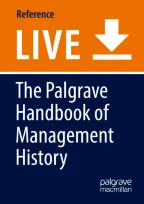Economic Foundations: Adam Smith and the Classical School of Economics

Although economic debates remain central to our world, they are wrapped in myth and misunderstanding. Many believe that Adam Smith provided the basis for classical economics through his exposition of the principle that outcomes are best decided through “the invisible hand of the market.” In truth, Smith never used the term, instead associating the concept of an “invisible hand” with self-interest. Smith’s ideas about self-interest were, moreover, derived from David Hume. Many of his ideas about value were obtained from the earlier work of Richard Cantillon. This chapter nevertheless argues that understanding of the foundational principles of classical economics – concepts associated with production as well as markets and exchange – remains central to our time. There is particular utility in understanding the nature of economic value and how it is created. For what is most revolutionary about the modern world is not its mechanisms for distribution and exchange but its systems of production; systems underpinned by the division of labor, the utilization of fixed capital, and the self-interested pursuit of occupational and firm advantage.
This is a preview of subscription content, log in via an institution to check access.
Access this chapter
Similar content being viewed by others

Economic Foundations: Adam Smith and the Classical School of Economics
Chapter © 2020

Cannan, Edwin (1861–1935)
Chapter © 2018

Classics Today: Smith, Ricardo, Marx
Chapter © 2020
References
- Braudel F (1986/1991) The identity of France: people and production. Fontana Press, London Google Scholar
- Burnes B, Cooke B (2012) Review article: the past, present and future of organization development – taking the long view. Hum Relat 65(11):1395–1429 ArticleGoogle Scholar
- Cantillon R (1755/2010) An essay on economic theory. Ludwig von Mises Institute, Auburn Google Scholar
- Chandler AD Jr (1977) The visible hand: the managerial revolution in American business. Belknap Press, Cambridge, MA Google Scholar
- Clark P, Rowlinson M (2004) The treatment of history in organisation studies: towards an ‘historic turn’? Bus Hist 46(3):331–352 ArticleGoogle Scholar
- de Montesquieu B (1748/1989) The spirit of the laws. Cambridge University Press, New York Google Scholar
- Decker D, Kipping K, Whadwani RD (2015) New business histories! Plurality in business history research methods. Bus Hist 57(1):30–40 ArticleGoogle Scholar
- Foucault M (1969/1972) The archaeology of knowledge. Pantheon Books, New York Google Scholar
- Foucault M (1976/1978) The history of sexuality – an introduction. Pantheon Books, New York Google Scholar
- Hayek FA (1931) Prices and production. G. Routledge, London Google Scholar
- Hobbes T (1651/2002) Leviathan. Broadway Press, Peterborough Google Scholar
- Hume D (1739/1896) A treatise on human nature, vol 2. Clarendon Press, Oxford Google Scholar
- Keynes JM (1931) The pure theory of money: a reply to Dr. Hayek. Economica 34:387–397 ArticleGoogle Scholar
- Keynes JM (1936/1973) The general theory of employment, interest and money. Macmillan, London Google Scholar
- Locke J (1689/1823) Two treatise on government. McMaster Archive of the History of Economic Thought, Toronto. https://socialsciences.mcmaster.ca/econ/ugcm/3ll3/locke/government.pdf. Accessed 17 Jan 2018
- Lyotard J-F (1979/1986) The postmodern condition: a report on knowledge. Manchester University Press, Manchester Google Scholar
- Lyotard J-F (1988/1991) The inhuman. Stanford University Press, Stanford Google Scholar
- Magnusson L (2009) Nation, state and the industrial revolution: the visible hand. Routledge, London Google Scholar
- Marshall A (1920) Principles of economics. Macmillan Publishers, London Google Scholar
- Marx K (1867/1954) Capital: a critical analysis of capitalist production, vol 1. Progress Publishers, Moscow Google Scholar
- Marx K, Engels F (1848/1951) The communist manifesto. In: Marx K and Engels F, selected works, vol 1. Foreign Languages Publishing House, Moscow, pp 32–61 Google Scholar
- Mill JS (1848/2002) Principles of political economy. Prometheus Books, New York Google Scholar
- Novecivic M, Jones JL, Carraher S (2015) Decentering Wren’s evolution of management thought. In: PG ML, Mills AJ, Weatherbee TG (eds) The Routledge companion to management and organizational history. Routledge, London/New York, pp 11–30 Google Scholar
- Piketty T (2012/2014) Capital in the twenty-first century. Belknap Press, Cambridge, MA Google Scholar
- Quesnay F (1766) Tableau economique. https://www.sapili.org/livros/fr/mc00222x.pdf. Accessed 16 Jan 2018
- Ricardo D (1817/1969) The principles of political economy and taxation. Everyman’s Library, London/New York Google Scholar
- Rothbard MN (2006) Economic thought before Adam Smith: an Austrian perspective on the history of economic thought, vol 1. Ludwig von Mises Institute, Auburn Google Scholar
- Rousseau JJ (1762/1950) The social contract. In: Rousseau JJ (ed Cole CDH) The social contract and discourses. Dent & Sons, London, pp 1–141 Google Scholar
- Schumpeter JA (1942/1975) Capitalism, socialism and democracy. Harper Perennial, New York Google Scholar
- Smith A (1776/1999) An inquiry into the nature and causes of the wealth of nations. Penguin Classics, London BookGoogle Scholar
- Voltaire (1733/2002) Letters on England. Pennsylvania State University Electronic Series Publication, Hazleton Google Scholar
- Voltaire (1756/1963) Essay on the customs and spirit of nations. In: Voltaire (ed Brumfitt) The age of Louis XIV and other selected writings. Twayne Publishers, New York, pp 240–311 Google Scholar
- White H (1973) Metahistory: the historical imagination in nineteenth century Europe. John Hopkins University Press, Baltimore Google Scholar
- Williamson OE (1976) Markets and hierarchies: analysis and antitrust implications. Free Press, New York Google Scholar
- World Bank (2017a) Global economic prospects, June 2017: a fragile recovery. World Bank Group, Washington, DC BookGoogle Scholar
- World Bank (2017b) On-line database: indicators – agricultural and rural development. https://data.worldbank.org/topic/agriculture-and-rural-development?view=chart. Accessed 8 Nov 2017
- Young A (1792/1909) Travels in France: 1787, 1788 and 1789. George Bell and Sons, London Google Scholar
Author information
Authors and Affiliations
- Griffith Business School, Griffith University, Nathan, QLD, Australia Bradley Bowden
- Bradley Bowden

